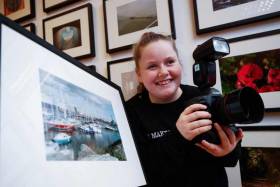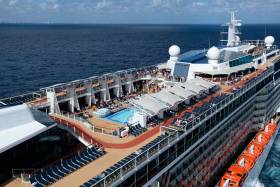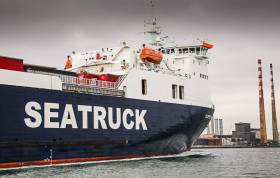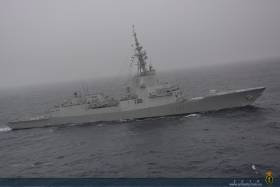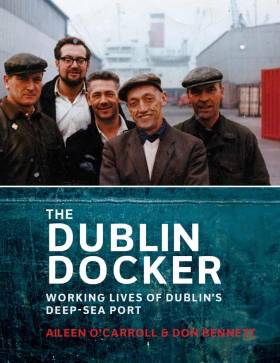Displaying items by tag: Dublin Port
Dublin Port Company: A Year in Review 2017
2017 has been a very productive year for Dublin Port. There has been sustained, significant growth across the business, from cargo to cruise, and it has also been a year of firsts on a number of fronts.
Trade
Latest trade figures show growth of 4.2% to the end of Q3 2017. A continuation in the current rate of growth to year–end would see 2017 become a third successive record year for Dublin Port. Total throughput (imports and exports) for the nine months to the end of September was 27.1 million gross tonnes, with 5,932 ship arrivals during the period. This is the fifth year in a row for Dublin Port to see substantial growth in the first nine months. Within that, growth was particularly strong in Ro-Ro freight with 736,462 units in the first nine months, an increase of 5.3% on the previous year. Meanwhile Lo-Lo containers grew by 4.1% to 515,718 TEU. Overall, volumes in Dublin Port have grown by 30.1% in just five years.
Infrastructure Development
With a return to the trend of year-on-year increases seen in the decades before the crash of 2008, and five years of consistent growth, works to increase the capacity of Dublin Port are advancing on the basis that growth will continue for many years to come. Works progressed throughout 2017 on both the Alexandra Basin Redevelopment (ABR) Project and the development of Dublin Inland Port located on a 44-hectare site just 14km from the Port. During the year, we also turned our attention to our next major project which, like all major port development projects, is being guided by Dublin Port’s Masterplan 2012-2040. The next significant project will focus on providing much needed additional capacity for Ro-Ro freight and container traffic to the UK, and increasingly to Continental Europe.
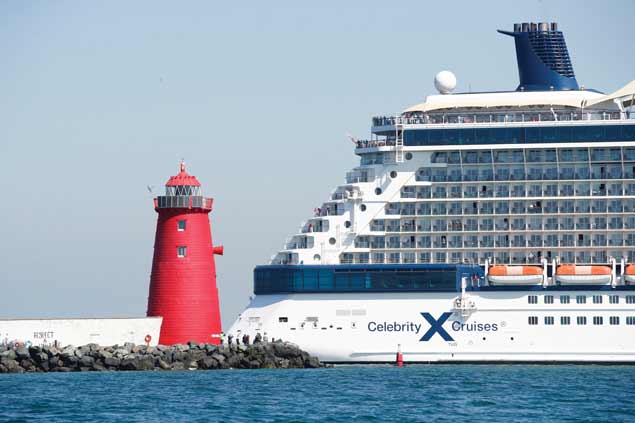 The 317m Celebrity Eclipse cruise arriving in Dublin on May 10 carrying over 4,000 passengers and crew on her maiden call to Ireland. The new arrival marked the start of Dublin Port’s 2017 cruise season that saw 130 cruise calls confirmed for Dublin Port this year, bringing over 200,000 passengers and crew to visit the city and benefit the local economy. Celebrity Eclipse will return to the city in 2018 when she becomes the first ship of a major cruise line to call Dublin Port a ‘home port’ Photo: Conor McCabe
The 317m Celebrity Eclipse cruise arriving in Dublin on May 10 carrying over 4,000 passengers and crew on her maiden call to Ireland. The new arrival marked the start of Dublin Port’s 2017 cruise season that saw 130 cruise calls confirmed for Dublin Port this year, bringing over 200,000 passengers and crew to visit the city and benefit the local economy. Celebrity Eclipse will return to the city in 2018 when she becomes the first ship of a major cruise line to call Dublin Port a ‘home port’ Photo: Conor McCabe
Homeporting - A New Departure
Four consecutive years of rising cruise tourism passengers to Dublin Port, and maiden calls by leading cruise lines, including MSC Cruises’ MSC Splendida, Holland America Line and Disney Cruise Line, have cemented Dublin Port’s position as a marquee cruise tourism destination on international passenger itineraries. Confirmation that Celebrity Cruises will base a number of Celebrity Eclipse turnarounds in Dublin next year, and news this year that one of the company’s newest Solstice class ships, Celebrity Reflection, will also homeport from Dublin in 2019, highlight growing momentum for turnaround cruises in the capital and, with that, bright prospects for the city’s wider tourism offering.
Opening Up Port Centre
An emerging port heritage trail now forms part of the city’s own tourism offering, and 2017 has been a landmark year in furthering its development with the opening up of Port Centre. The new public realm surrounding the company’s headquarters on Alexandra Road marks the largest physical intervention by the company to reintegrate Dublin Port with the city in 35 years and follows the reimagining of Dublin Port’s Diving Bell on Sir John Rogerson’s Quay.
The stone wall boundary surrounding Port Centre has been removed at intervals and replaced with new gate-like structures made from pre-rusted Corten steel. Opened, the gates reveal a newly reconfigured public plaza featuring a four-tonne stainless steel ball inspired by the Time Ball, which originally stood on the roof of the Ballast Office at the corner of Aston Quay and Westmoreland Street, and would drop to signal Greenwich Mean Time to ships in port.
Completing the new environs of the 1981 Scott Tallon Walker building is Crane 292, a refurbished 1960s Stothert & Pitt crane that once served as a workhorse, loading and unloading bulky material from ships at Alexandra Quay from 1964 through to its retirement in 1997. Restored to its former glory, Crane 292 is illuminated at night, providing a new addition to the docklands skyline.
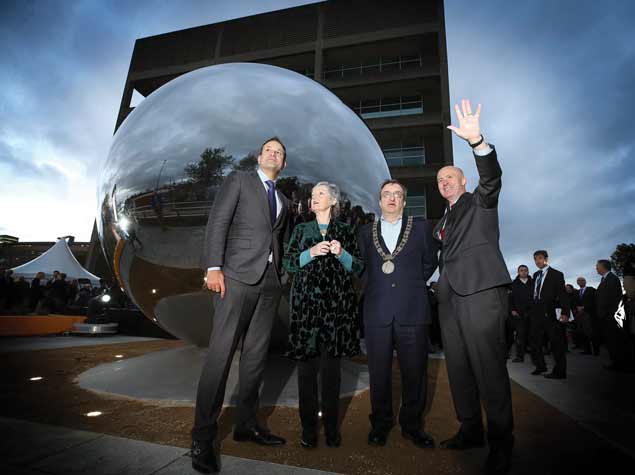 An Taoiseach Mr. Leo Varadkar TD, (left) with Lucy McCaffrey, Chairperson of Dublin Port Company, Lord Mayor of Dublin, Mícheál Mac Donncha and Eamonn O’Reilly, CEO, pictured after unveiling the new art insulation entitled “The Sphere” at the official ‘opening up’ of Port Centre following completion of a 12–month project to soften the Port’s boundaries with the city Photo: Conor McCabe
An Taoiseach Mr. Leo Varadkar TD, (left) with Lucy McCaffrey, Chairperson of Dublin Port Company, Lord Mayor of Dublin, Mícheál Mac Donncha and Eamonn O’Reilly, CEO, pictured after unveiling the new art insulation entitled “The Sphere” at the official ‘opening up’ of Port Centre following completion of a 12–month project to soften the Port’s boundaries with the city Photo: Conor McCabe
New Perspectives on Port – River – City
The modern port, its rich history and links with Dublin City and the River Liffey provided the inspiration and theme for Port Perspectives, Dublin Port’s visual arts commissioning series throughout 2017. During the year, the works of acclaimed Belgian artist Eugeen Van Mieghem went on display to Irish audiences for the first time in a major new exhibition at Dublin City Gallery The Hugh Lane, showing life in the Port of Antwerp at the turn of the 20th century.
Inspired by the exhibition, local community groups and schools saw their own works then go on display in the gallery. Sketches, watercolours, pastels and collages capturing images and memories from life at Dublin Port were created by young and old during a series of Drawing Club workshops. The artists ranged in age from as young as 11 to almost 80-years-old, and represented the communities of East Wall, Ringsend and Pearse Street.
Port Perspectives also featured new artwork from commissioned artists, including Sheelagh Broderick, whose Port Walks podcasts give recreational walkers along the Great South Wall an insight into working life aboard the vessels that enter the Port each day. Silvia Loeffler’s Transit Gateway mapped the changing shape of Dublin Port over the centuries, from its beginnings as a medieval shoreline to present day, in a series of seminars and accompanying artworks, while site-specific moving image installations were curated by Alice Butler & Daniel Fitzpatrick of Aemi and artist Cliona Harmey.
Ro-Ro in Focus
In a new development, CLdN’s MV Celine, the world’s largest Ro-Ro freight vessel, made her maiden call to Dublin Port in October, marking the start of a new service between Dublin and the ports of Zeebrugge and Rotterdam. With a capacity of 8,000 lane-metres carrying over 600 freight units, she will provide additional capacity and flexibility for customers trading with Continental Europe, particularly post–Brexit.
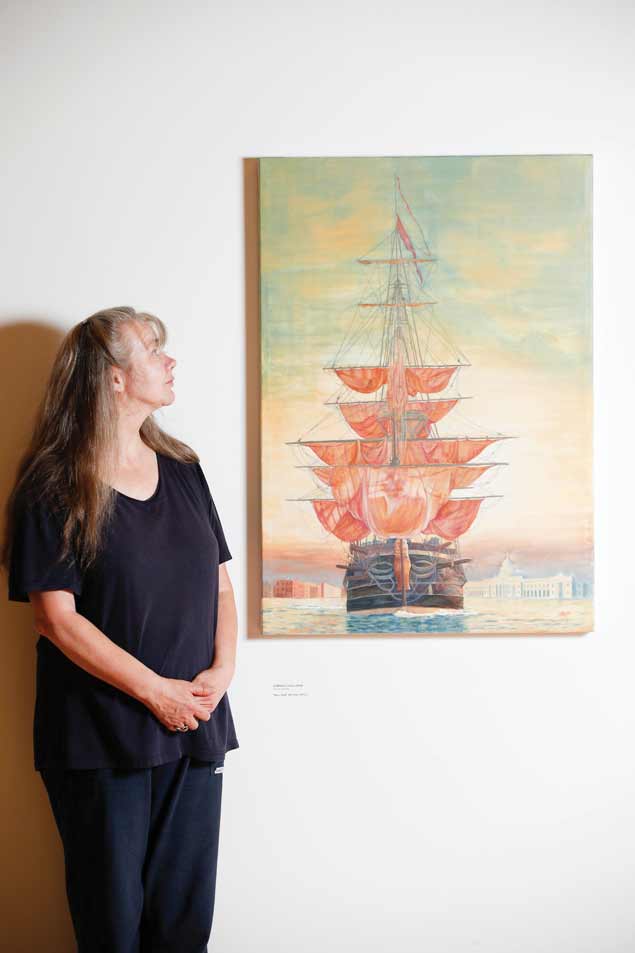 Dympna O'Halloran viewing her art work hung in Dublin City Gallery The Hugh Lane as part of Dublin Port's Port Perspectives Drawing Club Project in Ringsend and Irishtown Community Centre. More than 30 aspiring artists from Dublin's north and south inner city saw their art work displayed in Dublin City Gallery
Dympna O'Halloran viewing her art work hung in Dublin City Gallery The Hugh Lane as part of Dublin Port's Port Perspectives Drawing Club Project in Ringsend and Irishtown Community Centre. More than 30 aspiring artists from Dublin's north and south inner city saw their art work displayed in Dublin City Gallery
In Review
Earlier this year, Dublin Port Company published its report on the public consultation process for the first review of the company’s Masterplan 2012-2040, which makes provision for periodic reviews. The process, which involved extensive outreach to a wide range of stakeholders, will inform the revised Masterplan to be published. In the meantime, Dublin Port Company has undertaken a number of environmental, cultural, leisure and transport studies and assessments arising from the consultation process before finalising the review.
The significant growth of recent years meant that it was timely to review the Masterplan in 2017 and thereby ensure that the framework guiding the Port’s future development continues to reflect changing circumstances such as developments in policies governing planning, national transport, the environment and the economy.
Keep up to date with all the latest Dublin Port News on Afloat.ie here
Dublin Port Company Brings ‘My Port, River, City’ Student Photo Exhibition to the CHQ Building
Students from Ringsend College reveal their take on Dublin as part of an exciting new photo exhibition entitled ‘My Port, River, City’ which opens to the public today at the CHQ Building. The exhibition which runs until Sunday 10th of December is free of charge and showcases new works from over 100 budding young photographers aged 12 to 17 years old – for most of the students involved this represents their first official exhibition.
This special project is supported by Dublin Port Company’s Port Perspectives arts commissioning series and included a gift of digital camera equipment to Ringsend College to enable the students to take part. The students had the opportunity to work with professional photographer Mella Travers who mentored the group over a eight-week period as they developed their own bank of photography in response to the brief ‘My Port, River, City’.
The brief stems from Dublin Port’s drive to reconnect Port and City and to encourage new audiences to explore these areas through the medium of the arts. It entailed the students setting out to explore the greater Port area from the Great South Wall into the bustling Docklands. The students managed to capture unique moments across Dublin from windswept natural beauty to everyday moments in the City that go unnoticed.
Krystian Kilarski, a 4th year student spoke about how the project helped him develop a connection to the Port, River and City; “I live in Balbriggan and travel into Ringsend College each day. My family moved to Ireland from Poland seven years ago so I never really knew much about these areas, I barely even realised there was a Port! Since I took part in this project I have been able to develop a real connection to the Port, River and City.”
Abbie Cassidy, a 1st year student said; “It really is brilliant that we get to have our photos exhibited in the CHQ Building; it is a boost to my confidence to my see my photo there. It shows that teenagers can do some amazing things when we are given the opportunity.”
Darrel Poole, a 3rd year student said; “It has been great learning how to use the cameras with Mella, we’ve learned how to properly frame a shot, about lighting and how to use the cameras correctly. I think it is a skill everyone should learn.”
Mella Travers, a professional photographer has long ties to Ringsend College and speaks highly of the school’s commitment and holistic approach to their students’ education.
Mella Travers, Photographer, spoke about the experience of mentoring the students of Ringsend College; “The students put the hard work in and it has been wonderful to help foster their talent. This has been a very rewarding project just seeing the students grow in confidence in their abilities and believing in themselves.”
Eamonn O’Reilly, Dublin Port Company Chief Executive, said; “For decades, Dublin Port touched almost every family living in the vicinity of the north and south quays. This has been a very special project for us and we believe in putting time and support into local communities and the next generation. Not only are we helping these students learn a new skill we are encouraging them to make a connection to the Port, River and City and I would encourage people to visit CHQ this weekend for an inspiring exhibition.”
My Port, River, City will be open to the public from Friday 8th to Sunday 10th December between 11am – 4pm at The CHQ Building, 1 Custom House Quay, North Dock, Dublin and admission is free.
Seatruck Ferries Celebrate 10 Years of Operation in Dublin Port
#ferrynews - Freight ferry operator on the Irish Sea, Seatruck Ferries celebrate 10 years of service using Dublin Port from where the shipping company's traffic volumes have grown exponentially.
From small beginnings in October 2007, Seatruck had a single ship service using freight ferry ‘Celtic Star’. The ro-ro ship had previously ran for another operator Celtic Link Ferries on the Irish Sea. This operator no longer remains in business.
In that first year, Seatruck transported just over 3,000 units of freight from Dublin. Roll on a decade later and compare that figure to just under 21,000 units in October 2017, representing growth of well over 500%. According to IRN Freightstat, the operator are now one of the largest freight movers in the capital port.
In the busy midweek period Seatruck operate 4 daily services to Liverpool and a daily service to Heysham. Seatruck also operate on the Warrenpoint - Heysham route which commenced in 1996.
With driver shortages continuing Seatruck are expecting an ongoing switch to unaccompanied trailer movements which they specialise in with their purpose built freight only ferries.
CEO of Seatruck Alistair Eagles comments; “10 years on from the commencement of our services into Dublin port we are very much focusing on the next steps to ensure that we can continue to help our customers save money and use their equipment and drivers more efficiently. Seatruck is fully committed to our freight only model and we are planning for a continued industry switch away from the driver accompanied, short sea mode.
Our Dublin services are an extremely important part of our route network and I on behalf of everyone at Seatruck would like to personally thank all of our customers for their support”
In December, a new loading ramp will be installed in the Port of Heysham which will further enhance the operator's Irish Sea services from the UK Port, which is now directly linked to the motorway network via the new £130m M6 Link.
Seatruck are working closely with the relevant authorities in Northern Ireland on the Newry Southern Relief Road. The project will link Warrenpoint Harbour directly to the Belfast - Dublin motorway.
Dublin Port Becomes a Regular Feature for Celebrity Cruises
2019 is set to be an exciting year in the Irish cruise calendar as Celebrity Cruises confirms that Dublin Port will become a regular fixture. With five turnarounds in the port, Celebrity Refection will call Dublin home from May to June 2019.
In 2018 Celebrity Cruises becomes the first major cruise line to homeport a ship in the city when Celebrity Eclipse arrives in Dublin in April 2018, offering a mini season of five sailings. Due to the success of this inaugural season, Celebrity Cruises is continuing to feature Dublin as one of its prestigious homeports in 2019 and bringing a newer ship to Ireland. In 2019 over 15,000 holidaymakers will start their cruise holiday in Dublin with CelebrityCruises.
Celebrity Cruises will base the 3,030-guest Celebrity Reflection in Dublin in early summer 2019 offering a series of eight, 10, 11 and 12 night sailings. Cruises will sail to Iceland, destinations throughout Ireland, in the Norwegian Fjords and around the British Isles.
Celebrity Reflection launched in 2012 and is currently the newest ship in the Celebrity Cruises fleet. Featuring a real grass lawn on the top deck with private cabanas and the luxurious Reflection Suite – a one-of-a-kind two bedroomed suite with a shower cantilevered out above the ocean, and private butler service – Celebrity Reflection is one of the most stylish ships at sea.
The exciting expansion of Celebrity Cruises’ Ireland programme follows strong guest demand for cruises from Dublin, and the support of the Irish travel industry including travel agents and Dublin Port.
Lorraine Quinn, head of sales, Ireland, Celebrity Cruises, explains: “Sailings starting in Ireland from Dublin Port have been popular with our guests from all over the world. We are really pleased with the performance of the 2018 season for Celebrity Eclipse, and our 2019 deployment of a slightly larger ship in Celebrity Reflection to Dublin sees an increase in the number of people who will sail from this great city. Confirming our ongoing commitment to Ireland is a huge thank you to those who have aided Celebrity Cruises in becoming the first major cruise line to base a cruise ship in Dublin. I can’t wait to be part of the huge welcome that our guests will receive in 2018, 2019 and beyond.”
Pat Ward, Head of Corporate Services, Dublin Port Company adds: “We are delighted that Celebrity Cruises has chosen Dublin as the homeport for the deluxe Celebrity Reflection during 2019 confirming Dublin City as a marquee destination for the world’s largest cruise lines. Celebrity Reflection, measuring 319m long and boasting 14 decks, will be one of the most impressive cruise ships to arrive into Dublin Port. Our location at the heart of the city means that guests can maximise their time in the capital, relaxing in one of our many fine hotels while taking in the city’s sights, shops and attractions with ease. Dublin Port’s cruise business is growing from strength to strength. We are already on track for a record year in 2018, and with work on our Alexandra Basin Redevelopment Project having commenced, the future of cruise tourism to the capital is now secure.”
Both Celebrity Eclipse and Celebrity Reflection are part of Celebrity Cruises’ newest Solstice Class of ships, all introduced between 2008 and 2012. In addition to luxury guest accommodations, designer boutiques, extensive bars and restaurants, they also feature a real grass lawn on the top deck. With many awards particularly for its food and wine, Celebrity Cruises boasts the largest and rarest collection of wine at and sea and host of exclusive restaurants on-board all overseen by a Michelin-starred executive chef.
Celebrity Cruises continues to grow and expand its fleet with a new class of ship currently under construction. The first of those ships – Celebrity Edge – will enter service in December 2018.
Heads Up On Eden Quay: Historic Crest of the 'City of Dublin Steam Packet Company'
#CityOfDublin - It would be hard not to have noticed in particular as a Dublin bus commuter using services at Eden Quay the historic crest of the former City of Dublin Steam Packet Company, writes Jehan Ashmore.
The ornate masonry of the crest depicts the City of Dublin S.P.Co that was established in 1823 and later incorporated from 1833. The crest is to be found on the facade of 13-15 Eden House, on the first floor of the steam packet's former head office. Notably, such a crest is a very rare example in Dublin city and which has such historic shipping connections dating almost 200 years ago.
Facing almost opposite of Eden House are further bus stops located on the quay from where past Dubliner's could conveniently board City of Dublin 'steamers' to the rest of the UK. Noting that Ireland then remained as part of the Union.
The crest is of historical importance given the rarity of such architectural decorative features relating to our shipping heritage. Such an example should be recognised more so in the public domain as part of our national maritime past.
Eden House is on the corner with Marlborough Street where the Abbey Theatre's front entrance is located. To mark the significance of the 1916 Easter Rising centenary last year, images of leading historical figures were placed on the ground floor windows of Eden House. Currently they are adorned with those concerning productions held at the cultural institution also known as the National Theatre of Ireland.
As for the crest itself, the earliest date depicted is 1823 and this refers to when the Irish owned passenger services began when Charles Wye Williams inaugurated the Dublin-Liverpool service. In the following year this route was served by steamships City of Dublin and City of Liverpool.
Afloat will have a follow up on the crest and a more in depth background about the history of the City of Dublin Steam Packet. Also examined will be the relationship with other Irish Sea operators, among them B&I Line that has links to present day ferry operators connecting Dubin with Liverpool and Holyhead.
As developments continue in an increasingly changing city notably downriver in the 'Docklands', it is in this predominantly financial quarter where only a handful of further historical shipping related 'listed' buildings remain standing. These examples along the inner quays recalls an era from Dublin's older port.
The last regular trading ships from this part of the port were Guinness tankers that ceased operations in 1993. Originally the stout company loaded ships on the north side along Customs House Quay which was connected by barges upriver from St. James Gate brewery until this river trade ended in 1961. This led to road tankers taking over to supply the final pair of ships, The Lady Patricia and Miranda Guinness that transferred southside to Sir John Rogersons Quay.
As for Eden Quay's more central city location is located between O'Connell Street Bridge, the capital's main thoroughfare and the Butt Bridge completed in 1932. A previous bridge of the same name had been built at the same location albeit it was a 'swing' bridge that permitted navigation to shipping in the days of sail and steam.
It is along this stretch of the inner city Liffey quays is where commercial traffic exists in the present day albeit confined to the river. This been in the form of a single operator that been Dublin Discovered boat tours. Their excursion craft, Spirit of Docklands (see photo-story) embarks tourists from a berth pontoon at Batchelors Walk. From there the low-air draft craft regularly plies upriver to the Ha'Penny Bridge and as far as the Tom Clarke toll-lift bridge downriver where the modern port begins.
Dublin Port Trade Volumes up 4.2% in First Nine Months of 2017
Dublin Port Company has published its latest trade figures showing growth of 4.2% to the end of Q3 2017. Overall, volumes in Dublin Port have grown by 30.1% in just five years.
A continuation in the current pace of growth would mean a third successive record year for Dublin Port.
Summary of YTD September 2017 Trade Statistics
|
Gross tonnes |
Q3 2017 |
Q3 2016 |
% change |
|
Imports |
16.0m |
15.4m |
3.5% |
|
Exports |
11.2m |
10.6m |
5.2% |
|
Total Throughput |
27.1m |
26.0m |
4.2% |
|
Ro-Ro units |
736,462 |
699,361 |
5.3% |
|
Lo-Lo TEU |
515,718 |
495,511 |
4.1% |
|
Ferry passengers |
1,496,025 |
1,460,585 |
2.4% |
|
Tourist vehicles |
411,921 |
400,949 |
2.7% |
|
Cruise ships |
127 |
103 |
23.3% |
|
Trade vehicles |
73,252 |
77,494 |
-5.5% |
Total throughput (imports and exports) for the nine months to the end of September was 27.1 million gross tonnes, with 5,932 ship arrivals during the period.
Consecutive Growth over the past five years
This is the fifth year in a row for Dublin Port to see substantial growth in the first nine months.
|
Trade Period |
% growth |
|
Q3 2013 |
3.1% |
|
Q3 2014 |
7.2% |
|
Q3 2015 |
5.8% |
|
Q3 2016 |
6.8% |
|
Q3 2017 |
4.2% |
New Ro-Ro Service
Growth was particularly strong in Ro-Ro freight with 736,462 units in the first nine months, an increase of 5.3% on the previous year. Within this total, Ro-Ro services between Ireland and Britain grew strongly at 6.2%. Elsewhere, Lo-Lo containers grew by 4.1% to 515,718 TEU.
As Afloat.ie previously reported, In a new development, Dublin Port Company has confirmed that it will welcome the maiden call of CLdN’s mv Celine at the end of October. Her arrival will provide additional capacity and flexibility for customers trading with markets in Continental Europe, particularly post BREXIT.
Celine will operate between Dublin Port and the ports of Zeebrugge and Rotterdam. With a capacity of 8,000 lane-metres, Celine can carry over 600 freight units and is approaching twice the size of the largest ferry currently operating from Dublin Port.
The volume of new imported trade vehicles through Dublin Port declined by -5.5% during the period, reflecting the large increase in recent times of second-hand vehicle imports from the UK.
Ferry & Cruise Tourism Growth
Tourism volumes on ferries grew strongly in the first nine months, with passenger numbers ahead by 2.4% to 1.5 million. Cruise tourism is also growing in Dublin with 127 cruise ships calling in the first nine months of what is already a record year for Dublin Port.
Eamonn O’Reilly, Chief Executive, Dublin Port Company, said: “Dublin Port’s volumes continue to grow strongly. It is clear that the trend of year on year increases that we saw in the decades before the crash of 2008 has returned. We have now seen five years of consistent growth and each of the last three years has been a record year.
“Notwithstanding the uncertainty generated by BREXIT, Dublin Port has seen Ro-Ro freight volumes on routes to Britain grow by 6.2% over the first three quarters of 2017 with ferry passenger numbers growing by 2.4%.
“We are increasing the capacity of the port on the basis that growth will continue for many years to come. Work is continuing on our first major Masterplan project, the Alexandra Basin Redevelopment (ABR) Project.
“We are seeing increasing demand for direct freight services to Continental Europe. The introduction by CLdN of the 8,000 lane metre Celine will greatly increase the capacity on direct services to Continental Europe. BREXIT is creating a lot of uncertainty and the introduction of the new ship shows the shipping sector beginning to provide additional capacity to create more options for importers and exporters. We expect to see more new services to Continental Europe during 2018.
“Before year end, we will commence construction of a bridge over the Covanta and ESB cooling water outfall on the Poolbeg Peninsula now that the construction of the waste to energy plant is complete. This bridge will bring unused port lands on the Poolbeg Peninsula into use and allow us to increase the capacity of our berths on South Bank Quay. This is the first step towards the ultimate development of all Dublin Port lands on the Poolbeg Peninsula under our Masterplan 2012-2040.
“We welcome the recognition in the recently approved Planning Scheme for the Poolbeg West SDZ that port lands are for port uses. This follows on from the recognition in the draft National Planning Framework of the importance for the country of the continued addition of port capacity in Dublin.”
New Book on Dublin Bay's Nature & History
Dublin City is extremely vulnerable to coastal flooding which could cost at least €340 million in insurance claims alone, according to a new book, Dublin Bay – Nature and History (The Collins Press, price €24.99). Richard Nairn, one of three authors of the book, said, ‘Rising sea levels, increasingly severe storms and poor flood defences will combine to cause frequent flooding of property in the coastal areas of Sandymount and Clontarf.’ He added that there needs to be a high level of cooperation between all state and local authorities to ensure that the capital city is protected from the worst effects of climate change.
Eamonn O’Reilly, Chief Executive of Dublin Port Company, said, ‘The challenge to simultaneously manage, develop and conserve Dublin Bay is formidable and requires an appreciation of both the bay’s natural environment and its built environment.’
Weaving the kindred strands of history and nature, the authors tell the fascinating story of the bay. The development of the port city has been mirrored by major changes in the coastal environment. Geographer and planner Rob Goodbody, said, ‘The human and natural components of the bay have learned to coexist and, in some cases, even to depend on each other. We wanted to show people things like how the creation of Dublin Port caused the formation of Bull Island, or how the cockles and mussels immortalised in “Molly Malone” caused typhoid fever throughout the city.’ Co-author David Jeffrey, added, ‘The bay has stretched its arms widely to embrace countless generations of Dubliners: it is a life support system, an economic asset and an invaluable recreational resource.’ This new look at a familiar seascape authoritatively explains its importance to the past, present and future of our city and country.
Richard Nairn is a writer and ecologist from Dublin. He studied Natural Sciences at Trinity College Dublin and was the first Director of BirdWatch Ireland. He provides ecological advice to local authorities, and supported the UNESCO Biosphere designation of Dublin Bay. An active sailor, he has also walked all the shores of the bay.
David Jeffrey, Emeritus Professor of Biology at Trinity College Dublin, lives in Howth. He was a key researcher on the Dublin Bay Water Quality Management Plan and is a tireless advocate for science-based nature conservation.
Rob Goodbody from Dublin is a geographer and planner. He has written several local histories and regularly leads historic walking tours in Dublin.
Did you know that the River Liffey was much wider and shallower in earlier millennia, before it was confined between the quay walls. At low tide, the mud would have been too soft to support a person’s weight and the only crossing was a wide shallow section of the river, with wicker mats staked to the riverbed, which came to be known by the Irish name of Átha Cliath, or ‘ford of the hurdles’. The name Dubhlinn means ‘black pool’, referring to deeper water where the River Poddle enters the Liffey estuary. Thus, the names of the city itself related to the bay.
Dublin Port, which occupies the mouth of the Liffey, is the gateway for three quarters of the trade entering and leaving Ireland. Six ferry companies operate up to seventeen sailings a day to the UK and over a hundred cruise ships visit each year.
Dublin Bay had the first designated bird sanctuary in Ireland and it now has more designations than any other place in the country. The latest of these is its recognition by UNESCO as a biosphere.
The initiative of Dublin City Council in 2015 to extend the UNESCO designation of Biosphere to the entire area of Dublin Bay and its hinterland was innovative, forward-thinking and a model for good international practice in coastal zone management. The Biosphere is managed through a partnership between three coastal local authorities, Dublin Port Company, Fáilte Ireland and the National Parks and Wildlife Service. This promising start should be the first building block in a development that could cast Ireland as a world leader. In ecological terms, the biosphere is the global ecological system integrating all living beings and their relationships, including their interaction with the physical environment.
Launched in 1971, the Man and the Biosphere Programme (MAB) is an Intergovernmental Scientific Programme that aims to establish a scientific basis for the improvement of relationships between people and their environments. Still in place over four decades later, MAB combines the natural and social sciences, economics and education to improve human livelihoods and the equitable sharing of benefits, and to safeguard natural and managed ecosystems, thus promoting innovative approaches to economic development that are socially and culturally appropriate, and environmentally sustainable.
Price €24.99 / £21.99 • Hardback • 312 pages and available to buy online from Afloat's Marketplace here
- The book will be Launched on Thursday, 2 November in Dublin Port Company. The guest speaker will be Senator David Norris. More launch details here.
Spanish Navy Frigate Among NATO Flotilla to Visit Dublin Following Major Exercise off Scotland
#SpainScotland - French Navy ships are currently visiting Dublin Port with more to come among them the Spanish that also participated in Joint Warrior 172, Europe's largest military exercise for some time that had taken place off Scotland, writes Jehan Ashmore.
The UK led multi-national exercise involving some 30 warships from NATO, numerous aircraft, marines and troops had been testing anti-terrorism tactics, piracy, humanitarian missions and other duties. Asides the French and Spanish the multinational flotilla included the Royal Canadian Navy. All these navies are scheduled each to send a frigate to Dublin before next mid-week.
The French will again be represented by FGS Provence, the fourth caller since yesterday. The other frigates are the Canadian Navy's HMCS Montréal and from Spain Álvaro de Bazán. The country on 1st October drew worldwide attention given the independence referendum held in Catalonia. This was in marked contrast as only yesterday, 12th October was the National Day of Spain.
The “Álvaro de Bazán” class frigate belongs to the 31st Escort Squadron based in Ferrol, Corunna in north-west Spain. The frigate was launched locally in Ferrol on October 27th 2000 at the NAVANTIA Shipyards. The frigates motto and coat of arms is “Rey Servido y Patria Honrada” which translates to Served king and Honoured Homeland.
Another referendum but this time on Scottish independence took place in 2014. It was somewhat ironic that the 147m Spanish frigate had called to Glasgow only last week.
The leadship of the Álvaro de Bazán frigate class is of a modern design that according to the Spanish Navy has a remarkable military capability. The frigate is equipped with an AEGIS Combat System that makes the class a most valuable asset at the service of the Nation’s foreign policy, not only in conventional operations, but also in peace-keeping and humanitarian aid missions, enforcement of UN resolutions, etc.
This year, Joint Warrior 172 overlapped with Formidable Shield 17 - a U.S. led joint NATO live fire Integrated Air Missile Defence (IAMD) exercise. Both exercises had provided a complex environment in which allied units trained together in tactics and skills for use in a combined joint task force.
In addition our very own L.E. James Joyce, the second of three OPV90 /Playwright sisters completed, will dock in Dublin on Monday before this contingent of the NATO flotilla arrive. Firstly on Tuesday, HMCS Montréal is scheduled while on Wednesday it will be the turn of both FGS Provence and Álvaro de Bazán.
In the reporting of visiting naval vessels, the schedules can be fluid, so much so that due to operational reasons such ship visits can be swapped around, delayed or even be cancelled.
Dublin Port Ushers in New Era at Port Centre Opening
Guests of Honour Ardmhéara Bhaile Átha Cliath and Honorary Admiral of Dublin Port, Mícheál Mac Donncha and An Taoiseach Mr. Leo Varadkar TD were in attendance at the official opening of Dublin Port Centre. The project which began last November marks the largest physical intervention by Dublin Port to reintegrate the Port with the City, as committed to in the company’s Masterplan. The project has softened the Port’s boundaries to the City and provides public realm at Port Centre for the first time in 35 years.
MC’d by well-known broadcaster Eileen Dunne the 500-strong crowd, which was made up of members from the communities surrounding the Port, was serenaded by acts including Damien Dempsey, John Sheahan of the Dubliners, The Blades, Lisa O’ Neill, Colm Mac Con Iomaire of The Frames and Catherine Fitzgerald, many of whom were featured in Dublin Port’s 2016 album “Starboard Home”.
Speaking at the official opening ceremony the Ardmhéara, Mícheál Mac Donncha said: “It is a great honour to officially open Dublin Port Centre. The Port is such a huge part of Dublin City’s life and I believe with this project finally completed that connection is set to become stronger and stronger.”
Commenting at the event, Eamonn O’Reilly, Chief Executive, Dublin Port Company said: “Dublin Port is delighted to begin this new chapter of Port City integration. In recent years the connection has waned somewhat but this a new era for the Port. Rebuilding the connection between the Port and the City, which was so strong a century ago, is something which will be at the core of everything we do going forward.”
Speaking at the event, An Taoiseach Mr. Leo Varadkar TD said: “While Dublin Port’s key focus is on its infrastructural development and the import and export needs of the Irish economy, it also has a strong commitment to rebuilding the linkages between the port and the city. This new project will enhance Port-city integration to the benefit of city dwellers and visitors.
“Dublin Port is at the heart of what is emerging as one of the most exciting neighbourhoods in the city, and the opening of this port centre will add to the buzz and energy of this area, as well as providing locals with a host of new amenities to enjoy.”
Port Centre has been a hive of activity in recent months as the development of public space progressed. Projects included the removal of a section of the existing old boundary wall to create new pedestrian entry points at Alexandra Road and East Wall Road. Earlier this month the Port unveiled Crane 292 a newly restored crane from the 1960s which now stands proudly towering over Port Centre.
Visitors can now enjoy a landscaped “maritime” garden with seats for reflection and relaxation. NCAD graduate and up and coming Irish artist Eimear Murphy’s new sculpture ‘The Drop’ features in the garden. The sculpture is made from solid concrete and plays with notions of fluidity in its design. The commissioning of this piece highlights the Port’s long-term commitment to supporting the arts.
Dublin Port Company is now focused on plans for a new internal road network, cycle lanes and pathways. Approved by Dublin City Council and scheduled for development, the three-kilometre route will give pedestrians and cyclists access to the Port estate for recreational use for the first time. It includes a perimeter route with vantage points overlooking the Tolka Estuary.
Dublin Port Company today hosts the launch of The Dublin Docker, Working Lives of Dublin’s Deep - Sea Port, an illustrated book which recalls the era when thousands of men unloaded and loaded the ships by hand on Dublin Docks. The authors of the book Aileen O’ Carroll and the late Don Bennett excavated the archive of the Dublin Dockworkers Preservation Society to discover a wealth of photographs, spanning the mid-nineteenth century to the 1970s.
The Dublin Docker manages to capture the dockers’ arduous labour and the energy of Dublin Port. These evocative images bring the social history to life, complementing the voices revealed in interviews with the dockers themselves.
Dock work was physically hard and dangerous; coal was unloaded with a “Number 7” shovel which could lift up to 26kg of coal. Grain was shovelled into sacks, the dockers avoiding the fat rats which feasted in to the hulls. Timber beams and bags of cement were carried off on shoulders. Metal ore would make tongues go green.
Although the work was tough the humour which abounded among the dockworkers is evident through the colourful nicknames the men bestowed on one another; RubberLegs Gaffney, StakeLoaf Cummins and Professor Flood. The dangerous work lent itself to strong comradeship amongst dockworkers with the days broken up by song competitions and slagging matches.
For some dock work was the only option in lean times, with students and builders making their way down the docks in the summer months. In the 1960s it is recorded that 2,000 men were employed directly on Dublin docks.
The Dublin Docker is a history of the dockers and their deep-woven connection to the city. How they negotiated working hours and pay, the changes that came with epochal events – the Dublin Lockout, the First World War, the Easter Rising and War of Independence – and the innumerable myths and ‘dark stories’ that shrouded their image.
Commenting on the book Eamonn O ‘Reilly, Chief Executive, Dublin Port Company, said: “The Port has such a rich and vibrant history, we are thrilled to be able to support The Dublin Docker, which gives a voice to those men that were the lifeblood of the Port for so long. With the appointment of a Heritage Officer we can now bring more stories like this to life and honour the work of those that lay the foundation of what the Port is now and is set to become.”
Speaking at the launch, the co-author Aileen O’Carroll said: “As a Port city, Dublin owes much to the labourers who strove against the heavy-duty tide of imports and exports; a league of thousands who were hired on a day-to-day basis for generations, defining the bustle of Dublin city centre. The Dublin Docker is an illustrated history that determines the dockers’ and stevedores’ importance as an industrial subculture within the Dublin that they navigated.”






























